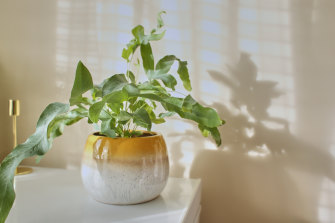Imagine a disco ball crossed with a swaying seaweed and tinted the colour of milky jade and you have some idea of the crazy appeal of blue star fern, Phlebodium aureum, var. glaucum.
This is the plant currently making my heart sing whenever I go outside. It’s growing in a hanging basket lined with coconut fibre and some time last year started punching through the sides of the basket. Now, in response to all the rain, the plant has exploded into a 360 degree ball of waving, blue-green jazz hands.
Phlebodium is one of the easiest ferns to grow, indoors or out. As proven by my giant dancing queen, it prefers humidity and moist, well-drained conditions in a position with morning light. It’s an epiphyte in its home in the tropical rainforests of Central and South America, growing in the crooks of trees and taking moisture and nutrients from the air and rain.
Phlebodium is one of the easiest ferns to grow.Credit:iStock
In the garden epiphytes are especially useful where it is hard to dig a hole, such as in the root mass of date palms, or around mature trees. All you need to do is position them where you want them to grow, perhaps with a tent peg or manipulated wire clothes hanger, and allow them to find their own way to secure themselves. Epiphytes for these kinds of conditions include bromeliads, tillandsias and crucifix orchids, as well as epiphytic ferns.
To enjoy the full craziness of a sphere of blue star fern though, you need a hanging basket. At first the furry finger-shaped rhizomes, which give the plant one of its many other common names, bear’s paw fern, will clamber over the surface, but given time they will start to force their way through the basket.
Indoors, Phlebodium is a fern for those who keep killing their ferns. Being epiphytic it wants a super well-drained mix, such as an orchid mix. It prefers a well-lit position but would rather be in a dim spot than one with direct sun. It’s easy to diagnose when you have it wrong: too much light will cause the fabulous eau-de-nil colour to brown, too little light and the leaves will fade and growth will slow right down.
Phlebodium tolerates neglect better than many other ferns, and also makes do with less humidity. Prune off the old leaves when they start to look messy, otherwise leave it alone. It’s a relatively slow-growing plant and doesn’t like being repotted, so wait til those furry rhizomes are trying to escape the pot before changing it up.
Like all ferns, this one reproduces through spores that appear on the undersides of the fronds.
The spores are tiny, but are collected in brown-yellow-orange clusters called sori. Each fern has a unique pattern of sori, which is like the fingerprint of that particular fern family. Phlebodium have quite large sori, arranged in dots on either side of the midrib. Yes, given those jazz hands fronds I am reminded of sequins.
Make the most of your health, relationships, fitness and nutrition with our Live Well newsletter. Get it in your inbox every Monday.
Most Viewed in Lifestyle
Source: Read Full Article
